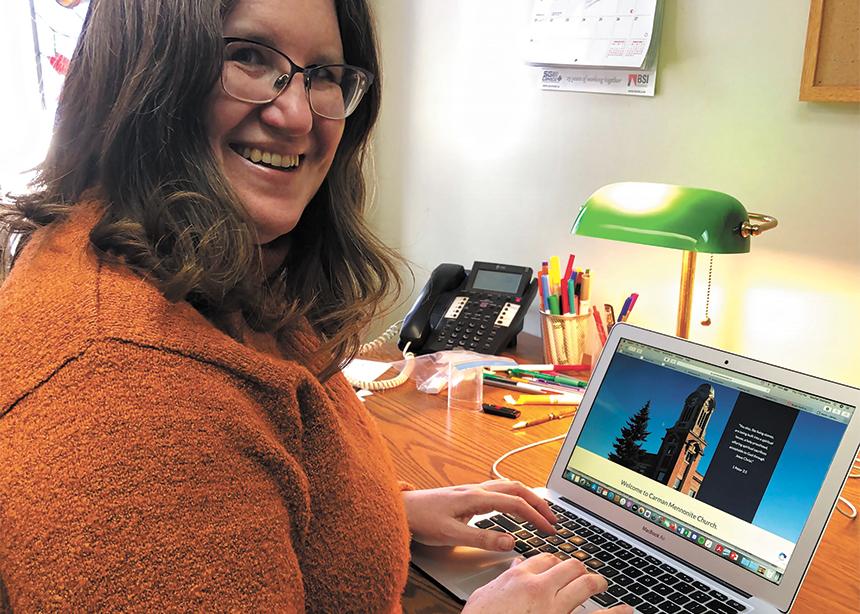Fifteen congregations have launched new websites through the Mennonite Church Canada congregational website hub.
“On the one hand, it’s hard work but it’s creative work,” says Rachel Siemens, pastor of Carman (Man.) Mennonite Church, whose website launched in August 2020. “What kind of images do we use, what do we say about us, what are the words we use to talk about ourselves?”
In February 2020, the five regional churches and MC Canada launched their new websites, which are part of a website hub created by Barefoot Creative, in Breslau, Ont. Shortly after, 21 pilot congregations were invited to join the hub to create new websites.
The platform offers several tools congregations have found useful during the pandemic.
First Hmong Mennonite Church in Kitchener, Ont., launched in May 2020, during the first wave of the pandemic. The congregation used the built-in event registration system to register service attendees when capacity was limited and contact tracing mandatory.
“This was important for ensuring we weren’t over capacity and helped to keep track of everyone’s information,” says Mollee Moua, who co-created First Hmong’s website.
Moua says the site will come in handy for the congregation’s plans to make digital Sunday school materials available for parents to download.
Siemens has been writing monthly e-mails to those in her community who are caring for aging parents and posting her messages in a blog on her congregation’s new website called “Caring for Parents.” The blog is highlighted on the church’s “Building Community” webpage.
People developing their congregation’s website work closely with Barefoot Creative from the beginning. Churches are given a pre-built template, which they manipulate to form into their own website. Barefoot provides training through instructional videos and online meetings, and staff respond quickly to questions.
Mennonite Japanese Christian Fellowship in Surrey, B.C., also launched in May 2020. In the frantic but necessary move to make things virtually accessible during lockdown, Pastor Gerald Neufeld worked hard to launch quickly, to enable online giving for the congregation, and to post sermons and weekly Zoom worship services on the website. To celebrate the congregation’s 20th anniversary, he posted a video of people bringing greetings even in isolation.
“Over half of the people attending our online worship services are from distant cities across Canada and Japan,” he says. “Through our website, e-mail and Zoom meetings we can now build connections with them.”
The Fellowship’s website can be completely translated into Japanese using Google Translate.
The creation of a website can feel daunting for some, especially when, on top of the technical details, there are decisions to make about content and exactly what to communicate to visitors.
A foundational component of the platform allows for interactivity between websites in the hub.
Edmonton First Mennonite Church launched in August 2020 and shares “News from the Broader Church” on its news webpage, allowing visitors to filter news from MC Canada and MC Alberta.
Likewise, Carman Mennonite’s news webpage features news from MC Canada and MC Manitoba.
“It’s a simple way to help keep us connected,” says Siemens, when asked why she chose to integrate nationwide and regional news onto her church’s website.
Jon Olfert, director of MC Alberta’s Camp Valaqua, whose website launched in February 2021, says the most helpful thing the platform allows is for camp donations to be processed through MC Alberta’s website, cutting down on administrative steps for his staff.
“It simplifies life for our treasurer, which is always a good thing,” he says.
Edmonton First Mennonite also makes use of a built-in intranet function that comes with the platform. Congregational members can log in to access secure pages of their website, where documents like board minutes, bulletins, policies and congregational listings can be placed.
Along with the registration, news integration and donation-processing abilities, the hub also offers congregations the ability to track donations, manage donor mailing lists, manually add giving by cash or cheques, and issue tax receipts directly from the site.
“We are committed to empowering churches and Christian ministries, especially in the difficult months of COVID-19,” says Gayle Goosen, creative director of Barefoot Creative. “Our goal is to make it easy for churches to have an online space that tells their unique story. We’re excited to see churches across Canada creating unique and engaging online environments for their congregations.”
All MC Canada congregations are invited to join the congregational website hub. Interested congregations can contact their regional churches for more information:
- MC British Columbia: Kevin Barkowsky (info@mcbc.ca)
- MC Alberta: Tim Wiebe-Neufeld (tim@mennonitechurch.ab.ca)
- MC Saskatchewan: Josh Wallace (churchengagement@mcsask.ca)
- MC Manitoba: Rick Neufeld (rneufeld@mennochurch.mb.ca)
- MC Eastern Canada: Norm Dyck (ndyck@mcec.ca)





Add new comment
Canadian Mennonite invites comments and encourages constructive discussion about our content. Actual full names (first and last) are required. Comments are moderated and may be edited. They will not appear online until approved and will be posted during business hours. Some comments may be reproduced in print.